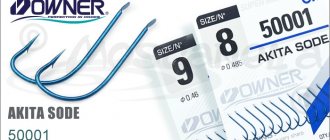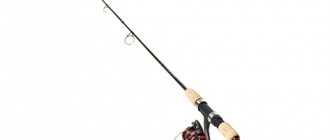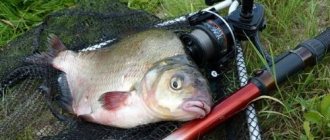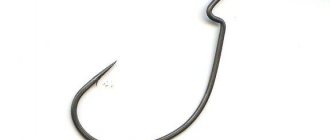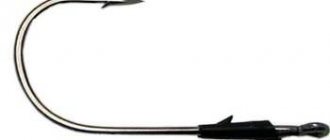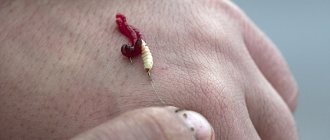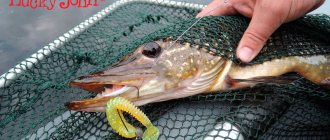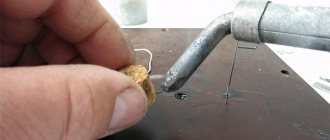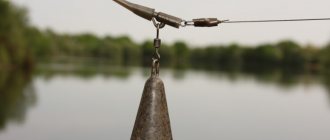What is an offset hook for and where is it used?
It is used in jig spinning fishing in various equipment options. Its main purpose is to hold the silicone bait in such a way that when fishing there is a minimum of snags on bottom obstacles: stones, grass, plant stems, branches of coastal bushes. It can be considered that an offset rig is the simplest version of non-snacking gear. As any angler knows, fish love places where it is least convenient to catch them.
They are used for jig rigs, both the usual, most common one, with a Cheburashka weight, and more complex ones, such as a drop-shot, with a retractable leash, or Carolina gear. These rigs in the classic version are equipped with a single hook, which is assigned a rather difficult task:
- It should not interfere with the play of the bait during uniform or stepped wiring.
- It should reliably detect fish during hooking and give a minimum number of escapes.
- With its help it should be convenient to place and remove baits, changing them and using different types if necessary.
- He must hold these baits securely, allowing a predator to grab them, and at the same time not injure these baits too much, so that they last as long as possible.
The types of offset hooks are determined by their use.
Basic installation methods on offset presses
The scope of offsets is impressive. They can be used to solve narrowly targeted problems in a specific situation, or they can be used to make universal equipment that can catch in various conditions in any reservoir.
As mentioned above, offset is very popular in combination with hinged mounting. But more often it is used in various versions of spaced equipment, such as
- diverter leash;
- Texas with a bullet load;
- Carolina rig;
- drop shot;
- split shot.
The invention of offset made fishing in hard-to-reach places more efficient and less expensive. You can fish with offset in places where it is impossible to do without it.
- Wobblers for pike in spring. Rating of the best
- Legendary spinner Mepps Syclops
- Choosing a twister for perch
- Edible rubber
Types of offset hooks and their features
One of the main features that anglers pay attention to is the significant size of offset hooks compared to tees, which are traditionally placed on spinners and wobblers. Indeed, the size of the hook is sometimes two or three times larger, it can range from one centimeter for a not too large perch to about five to six centimeters for a good pike, and even be even larger.
The second feature is the presence of an additional bend near the eyelet and the eyelet itself. As a rule, the hook has a large eye, with which it can not only be tied to a fishing line, but also conveniently attached using fairly thick fasteners to a leash, equipment or swivel. At the same time, the equipment itself must maintain mobility, that is, the eyelet itself is made in such a way that it can move freely on the clasp.
of 90 degrees, and double in the form of the letter Z. The bend serves to hold the bait and, in some cases, to tie it to the fishing line, such as in a drop-shot rig. The most commonly used is the second type of bend in the form of the letter Z; the second type of offset hook for attaching silicone baits is used only in drop-shots.
There are also many other options, mainly related to additional equipment. For example, a variant with a spring is often found. It allows you to place silicone on an offset hook in such a way that it is minimally injured even when biting hard and playing fish, when it clings to the teeth of a large pike and does not pull out of the hook completely.
The second common option for additional equipment is an offset hook with additional weight. It allows you to do without additional weight and is attached directly to the body of the hook. This equipment option allows you to orient it upward with the sting immediately when diving, which avoids snags. And due to the absence of additional equipment elements in the form of weights and fasteners, it can easily pass among grass and other vegetation and provides a minimal number of hooks, although the size itself should be significantly larger than without weights.
Installation of offset hook sinker
With the advent of offset hooks, anglers came up with many options for equipment used in various fishing conditions. There are highly specialized options that are effective only in specific conditions. And there are universal ones that are suitable for almost any fishing.
Hinged mounting
This is a combination of a collapsible sinker (“Cheburashka”) and an offset hook. The sinker is very easy to disassemble - just remove the wire bracket, place the hook on it behind the eye and put the weight back together. Then the selected bait is attached to the hook.
Texas rig
The equipment was specially created for fishing in hard-to-reach places. In this type of equipment, the sinker is made in the shape of a bullet. In the back of the sinker there is a recess and a place to place an offset hook with a silicone bait. In the recess of the sinker you can successfully hide the protruding eye of the hook. This way the equipment will be smooth and will not have protruding parts.
How to assemble:
- Attach a bullet weight to the main line. Its sharp end must be directed towards the rod;
- put the shock absorber on the fishing line. Its role can be played by a small bead or a special silicone device;
- Fix the offset hook on the fishing line.
The finished bait is fixed on the hook.
Carolina rig
In this type of equipment, all elements are spaced relative to each other. With its help, they effectively catch fish in the bottom layer. The fisherman can fish hard-to-reach areas with a lot of snags, vegetation, stones and shell rock.
How to mount:
- A drop-shaped sinker is used. Thread a fishing line through the hole in the weight;
- fix the cambric (bead) on the fishing line;
- then tie the swivel;
- Attach a leash to the swivel with a blanket on which the bait is strung. Use the clinch knot.
Retractable leash
The equipment of an offset hook on a retractable leash is considered the simplest. Its main feature is that the hook with bait and the sinker are located on the same line. Even a beginner can install such equipment. It is effective in bottom fishing for pike and pike perch.
How to assemble:
- Attach a sinker to the end of the main line;
- fix the loop 20 cm above the sinker;
- Tie a leash with an offset machine equipped with bait to the loop.
Jig rig
Another equipment that makes it easier to fish in difficult areas with sharp edges and drop-offs. For installation, you will need to prepare an offset press, winding rings, an elongated sinker, and a silicone bait. The sinker should have an eye for attaching to the fishing line, located in its narrowest part.
How to mount:
- connect the winding ring to the winding ring;
- insert the second into the first winding ring. In turn, insert an offset press into it;
- equip the hook with bait.
The equipment is ready, now you need to fasten it to the main line using a clasp.
Tokyo rig
This type of equipment can be called “young”. It has existed for about 7 years, but has already become popular among fishermen. There was also a second name for it - Chupa Chups. Ready-made tackle can be purchased at the store and mounted on a fishing rod using a carabiner, following the manufacturer's instructions. Experienced fishermen recommend making your own tackle. In this way, it is possible to take into account the specific conditions of the reservoir in which it is necessary to hunt for river predators - pike, catfish, pike perch.
How to install it yourself:
- put the sinker on the wire (the optimal shape of the sinker is “bullet” or “olive”). It will be necessary to fix it in place, make a stopper on one side, and a ring on the other;
- equip the hook with silicone bait;
- collect all the elements in a carabiner with a swivel. You can also choose a winding ring for fixation.
The design of the Tokyo rig equipment should be as flexible as possible. The peculiarity of this gear is that when it gets into the water, it not only imitates the movement of small fish, but also makes noise. To enhance the noise effect, it is worth attaching not one weight, but two or three. The offset hook appeared not so long ago, but experienced fishermen liked it almost immediately. It allows you to fish in hard-to-reach places and keep the hook and bait intact for several casts.
Hook bend shapes
In total, three types of bending are used in practice, and each of them is intended for its own purposes:
- Texas rig - a regular arched bend behind the straight forend, followed by a bend near the lug. The very first offset hooks for silicone were just like this; this form is still popular in drop-shot rigs.
- Wide gap - a wide bend; unlike the Texas one, there is no clearly defined straight section of the forearm. On the contrary, the offset machine turns out to be much wider and has a greater number of bites. The sting from it needs to be brought out when using a silicone bait; it injures the bait itself much less.
- Sickle hook - a crescent-shaped bend with a clearly defined curved area right next to the sting, the sting itself is also wrapped inward. These give more bites when biting passively, in addition, they themselves are small in size, which sometimes affects the number of fish caught.
Expert opinion
Forester Seva
Expert
Ask a Question
Wide gap is by far the most popular and frequently used hook bend shape. This form can be divided into two varieties. The first is when the sting points exactly to the ear. Used for worms, slugs, twisters, and other narrow baits. The second is that the sting is higher than the ear. Used when you need an offset hook for a vibrotail or other wide bait.
The Texas Bend originally came first, but is little used today. The fact is that with such a bend it is necessary to hide the tip a little in the bait, and when the fish bites, it breaks through its top layer and releases the sting, making it possible to hook. Naturally, this does not have the best effect on the lifespan of such bait. Therefore, they are more often used on relatively large and coarse baits, which, being slightly frayed on one side, can be turned over on the other and continue fishing.
In addition, this type works worse with hard silicone - only high-quality soft silicone is needed here. And the shape does not have the best effect on the implementation of bites - the fish needs to actively grab the silicone in order to be hooked, this does not always happen. However, in drop-shot type rigs, this option is used quite often, when you need to directly tie the hook to the leash from the fishing line, and then the loading comes. A bait with such a hook looks most natural in the current, constantly oriented in the right direction, while at the same time, as on another hook, it can turn over and take strange positions, only scaring off the fish.
The crescent hook was originally used in jig heads. This shape allows you to effectively hook fish and, according to many fishermen, is self-hooking. The author, however, is sure that this form still requires control and cutting. The main thing that distinguishes this form from others is that with its use you can use a much smaller hook size, this will not affect the implementation of bites.
The sickle-shaped one may also have, in addition to the “claw” on the sting, an additional transverse bend of the sting to the side - the so-called 3d bend. This will increase the chance of catching a fish that has bitten, since in this case the hook is likely to dig into the corner of the mouth, where the tissues are softer and easier to cut through. At the same time, this may not be very practical for cutting through the hard palate; more force will be required when cutting.
Basically, when fishing, the first two variants of the form are used, so further we will only talk about them.
Offset hook numbering and size table
It is very different from the numbering used for classic float and bottom fishing. The fact is that offset printers are much larger than there, although the same system exists for them. Nowadays the English numbering system , where for a large number the designations 1/0, 2/0 and so on are introduced, up to 5/0 - the largest size.
The fact is that in this system the largest one goes under number 1, and the smallest one that is found on sale is 14. Probably, in order to show how much larger this hook is than number 1, it is assumed that it goes under number 0, or 1/ 0. Next comes 00, 000 and so on, up to 00000, or five zeros, 5/0. Since offset hooks are very large, they only have “zero” numbers. In practice, even 1/0 is very rarely used, so 2/0 or greater should be considered.
| Offset press dimensions in mm | International (English) numbering | Domestic classification |
| 16 | 3/0 | 16 |
| 14 | 2/0 | 14 |
| 12 | 1/0 | 12 |
| 10 | 1 | 10,0 |
| 9 | 2 | 9,0 |
| 8,5 | 3 | 8,5 |
| 8 | 4 | 8,0 |
| 7,5 | 5 | 7,5 |
| 7 | 6 | 7,0 |
| 6,5 | 7 | 6,5 |
| 6 | 8 | 6,0 |
| 5,5 | 9 | 5,5 |
| 5 | 10 | 5,0 |
| 4,6 | 11 | 4,6 |
| 4,4 | 12 | 4,4 |
| 4 | 13 | 4,0 |
| 3,6 | 14 | 3,6 |
| 3,4 | 15 | 3,4 |
| 3,2 | 16 | 3,2 |
| 3 | 17 | 3,0 |
| 2,6 | 18 | 2,6 |
| 2,4 | 19 | 2,4 |
| 2,2 | 20 | 2,2 |
| 2,1 | 21 | 2,1 |
| 2 | 22 | 2,0 |
| 1,9 | 23 | 1,9 |
What is the true size of these hooks? The distance from the tip to the forend, if its size is 1, is approximately 10 mm. Further, the dimensions according to this classification increase by 2 mm, if you go to the “zero” range. That is, a 1/0 hook will be already 12 mm wide, 2/0—14 mm, 3/0—16 mm, 4/0—18 mm, 5/0—20 mm wide. In practice, using 2/0 and above means that hooks with a width of 14 mm or more are used.
However, here everything will also greatly depend on the type of bend itself. For example, the Texas rig allows you to quite clearly determine the distance from the forearm to the sting, since its shape is very similar to a regular fish hook. But for the Wide gap shape it is more difficult to determine this figure; it does not have a clearly defined straight forearm, it is curved. In fact, even with the same number, these hooks will be visually different in size - the Texas one will look smaller.
Are smaller hooks used when jig fishing? Yes, they do apply in some cases. Mainly when it comes to jig heads. There, indeed, you can often find the use of numbers 1, 1/0, but only when catching small perch. Also, ultralight with a jig head is often caught with smaller hooks. The fact is that using small hooks will not only not allow you to place a quality bait on it, but will also result in an excessive number of catches.
But you should not use too large hooks in all cases. A small bait placed on a large hook will have an unnatural action, too harsh.
Especially when it comes to vibrating tails - for them you can take slightly smaller hooks than for other baits, for example, worms. Therefore, you should always try to match the size of the bait. If it is too large for the fish itself, but the bait plays well, that’s okay. Even at 4/0 it is quite possible to catch palm-sized bass if they like big rubber bands at this time of year.
Offset hook sizes by numbers for different fish
Depending on the type of fish, offset hooks are used from number 2/0 to number 5/0.
For pike
Pike are traditionally caught using the largest rubber bands. Therefore, if offset hooks are used for pike, then the largest ones are 5/0 and 4/0. With this one you can easily hook and catch even a thirty-centimeter “pencil”. Not to mention the measured herbs weighing 300–400 grams. If they catch a large predator, then the hook for the pike is already much larger - only 5/0 and nothing else.
However, pikes are not caught with an offset hook too often. The fact is that pike bite better on bait that is not located at the bottom, but in the water column and with a uniform retrieve. Therefore, a head is best suited here, rather than an offset press. Accordingly, the hook size should be 2/0 or higher. But this is only for heads.
In practice, quite often, instead of a head when fishing for pike, they use an already loaded offset. This is often practiced when fishing among grass, while casting under reeds or in the windows of water lilies. A loaded offset machine may well imitate the behavior of a jig head, but it should still be used only where the use of the head is limited due to many hooks. A head with an upper eyelet behaves completely differently in water than an offset machine and handicraft heads that were popular in post-Soviet times, which had an eyelet at the front. The hook size for a pike, which is already initially pre-loaded, should be around 5/0.
For perch
Perch is a much smaller fish than pike, so miniature baits are often used for it. Their type also differs: if for pike they used mainly a vibrating tail, sometimes it happens to put a twister on a hook, and only occasionally - worms, crayfish, octopuses, then for perch a twister on an offset hook is usually the main fishing tool, followed by worms, then crayfish, The vibrotail is not placed on an offset hook so often, and the author has not seen a single bite from a perch on an octopus. However, this is all the opinion of the author; everyone here will have their own personal experience. Smaller baits require a smaller hook. 2/0—4/0 will do just fine here.
Perch is often, more often than pike, caught using edible rubber. Therefore, the question arises whether the same size should be used for edible rubber and for regular rubber, or whether it is better to use some other size. In practice, whether it is edible or regular does not matter. However, in reality, edible rubber is usually more rigid; there is probably some influence of special edible impregnation.
Therefore, the choice of hook should be approached more carefully. You should try to use a larger one, because usually harder rubber will behave worse when hooking, even when the fish has managed to chew it. At the same time, you need to make sure that the hook does not extend beyond the inactive body of the bait, that is, does not interfere with its play.
For zander
Pike perch is a fish that many people catch incorrectly and therefore do not catch often. In fact, the fish is quite common; at night in summer it comes out to feed on sandy and pebble shallows, and during the day it tries to stay in deep places. The largest pike perch almost never emerge from them at all, since it does not need to actively feed - the fish’s metabolism slows down significantly with age.
Expert opinion
Forester Seva
Expert
Ask a Question
The main catch of a spinning angler when fishing with an offset hook on an elastic band is small and medium-sized pike perch. The same baits are used as for perch. However, the hook for pike perch must be large. In fact, the only applicable number for this fish is 3/0, and only occasionally 4/0 is used when the size of the bait allows it.
At the same time, in the author’s opinion, the most successful way to catch this fish in the current is to use a drop-shot type rig at night and in the evening, which allows you to literally stop the rig and play along with it, practically without moving it at one point. In still water, the drop shot is used much less frequently, and it is possible that it will also perform well there.
For drop shots, it is convenient to use Texas-type offset presses, Texas rig. They should be chosen a little larger than the Wide Rig in order to cut through the pike perch mouth well. By the way, not only the size matters here, but also the thickness of the wire from which it is made. For pike perch you need to use thick wire, as it is more reliable when hooking, less shock absorbent, although it seriously injures the silicone. Regarding edible rubber for pike perch, the recommendations are the same as for perch, the hook does not differ much in size, but you need to be more critical in choosing it, taking a larger one if possible.
Selection rules
Choosing an offset hook is not easy at first glance. Inexperienced fishermen often get confused about the numbers when trying to fit an existing bait to a hook they have already purchased. When choosing a specific equipment, it is recommended to try on the bait and offset. How to do it:
- choose bait and hook;
- attach the silicone bait to the offset machine.
It is necessary that the hook point falls in the middle of the body of the selected bait. If there are options, it is better to choose the one where the sting sticks out less. It is important to take into account that the height of the bend of the equipment corresponds to the height of the body of the bait.
The best manufacturers
Despite the large assortment of different offset hooks and baits on store shelves, among them there are a number of manufacturers whose products are trusted by the majority of fishing enthusiasts.
| Company name | A country | Peculiarities |
| Owner | Japan | sharp tip - the manufacturer has provided several sharpening options, which differ depending on the offset press model; strong and durable; a wide range of models, each with its own material. |
| Decoy | Japan | material of manufacture - high-carbon steel; sharp sharpening; a wide range of models, differing in eye size, wire thickness and other indicators; the presence of specific models - with a propeller in the front part, with shipping on the hook. |
| Varivas | Japan | manufacturing material - high-carbon thin wire; high elasticity and hardness; fine sharpening of the tip; thin wire does not tear the soft silicone of the bait. |
| Gamakatsu | Japan | acid sharpening; a huge number of models; a large number of sizes; durability. |
| Saikyo | Japan | wide range; line of thick and thin wire; production method - hot stamping; unique shape; acid sharpening; shock-absorbing effect. |
| VMC | France | made of vanadium steel alloy; lightweight but durable; high-grade sharpening; patented forend shape. |
| Fanatik (Fanatic) | brand - Ukraine (produced in South Korea) | material - high-carbon steel; anti-corrosion treatment; chemical sharpening; large eye; durability; high-quality step; low cost. |
| Crazy Fish | brand - Russia (made in South Korea) | wide range of sizes; excellent sharpening performance; durability; low cost. |
| Hayabusa | Japan | chemical sharpening; anti-corrosion treatment; light weight; perfect balance; durability. |
| Lucky John | Latvia | sharp sting; comfortable beard; material of manufacture - high-carbon steel; high strength indicators with minimal wire thickness; reliable step; low cost. |
Offset hooks for microjigging
Microjig is a separate topic that not everyone is familiar with. The fact is that in the classic version, this type of fishing can rarely be used for fishing from the bottom or in the near-bottom layer.
And for fishing in the grass, snags and strong places, this method will be quite controversial - an ultra-thin nanofile will not withstand snags even on thin grass, and tearing a hook out of sedge or reeds will be an impossible task for it. And almost all offset machines are made with the aim of giving fewer hooks and catching from the bottom and in strong places.
Therefore, for microjig they use not offset hooks, but all kinds of heads, which are used to move the bait in the water column, sometimes on top. Accordingly, fish such as asp, chub, ide, and rudd will often become prey here. If they install an offset machine, then at least a Cheburashka weight is used, which is never used for small scales.
Sometimes you can find a modification of a standard offset jig for microjigging, when a weight is placed on a small hook, similar to a pre-loaded hook for fishing in the grass.
Perhaps such equipment will show itself. But under the same conditions, a regular head will be much more catchy, and it is better to leave the hook for fishing in the grass. Its size, if you take a hook with a weight, will already be quite substantial, which does not fit into the concept of microjig - you can just as well fish with a regular spinning rod, with normal dough, braid, or reel.
Offset hook - what kind of tackle?
The offset hook came to us from the USA. There it is called Texas rig. After appearing in stores in our country, hooks with an unusual double bend in the shank were perceived as defective. And only after some time, fishermen were able to learn about the benefits of offset fishing. It took time to get used to fishing with the “American” innovation. It turned out that the gear significantly increases the efficiency of fishing for river predators in difficult conditions.
An offset hook is an unusual tackle with two bends, which allows you to bait the bait in such a way as to hide the sting. The resulting tackle can be safely carried through overgrown, littered and places with a large number of snags.
What are the differences from a regular hook?
Regular hook
Distinctive features:
- zigzag bend. It makes it possible to firmly fix the bait. It will play in the water column, creating the illusion of a living fish, but will not fly off;
- the ability to hide the hook tip. For this purpose, a special recess is provided or it is hidden directly in the body. This allows you to use the tackle in places where it is impossible to fish with spoons and spinners. They simply cling to surrounding snags, plants or stones. The offset specialist creates an active bait that successfully passes all obstacles.
What is an offset hook for and where is it used?
The main application of the offset hook is spinning fishing. The peculiarity of the hook, which allows you to hide the sting in the body of the bait, allows you to use the tackle in such fishing conditions where it is necessary to drag it along the bottom and not make any snags.
The offset hook is effective for bottom fishing in the following areas:
- rocky;
- with snag;
- filled with flooded dead wood;
- densely overgrown;
- with a lot of garbage.
The offset machine works great together with silicone soft baits such as vibrotail, twister, worm, slug and others. A well-mounted bait (fish or crustacean) smoothly avoids all possible obstacles without snags, playing effectively and attracting the attention of a predator. At the moment of a bite, the sting of the hook is released from the silicone case, piercing the lips of the fish and holding it on the hook.
Offset hook or jig head - which is better?
On thematic forums of anglers, passions do not subside about which equipment is best suited for catching predators. Some people are all about jig heads, while others prefer to fish exclusively with an offset jig with a Cheburashka. So which is better?
Jig head
| Offset hook | Jig head |
| hinged mount of the bait, allowing it to move freely; animation of the bait without wiring; suitable for fishing in rocky, overgrown places; the hook point is hidden, the hookability is slightly worse. | the bait is rigidly connected to the sinker; when touching the bottom, it remains motionless if there is no wiring; suitable for bottom fishing with a clean base; better hooking performance due to the open hook tip. |
Offset hook for different baits: how to attach and select the size
Most often, four types of silicone baits are used with an offset machine:
- Twister is a classic.
- Vibrotail is also a classic, but different.
- Worm.
- Cancer.
The twister, vibrotail and crayfish have a clearly defined body. In the vibrotail it is wider, in the twister and crayfish it is narrow and elongated. Worms have a long and almost straight body, which only has active play. They can be smooth or ribbed, depending on the design. Crayfish are a special bait that is attached identically to a twister, but it is important to choose the right head and tail.
For a fisherman, it is important not only to put rubber on an offset hook with high quality, but also to preserve it for as long as possible. Therefore, when using offsets, most often the bait is placed on it once and then not changed. The fact is that frequent replanting spoils the silicone body; it will not withstand more than three to five such cycles. Therefore, anglers strive to correctly and efficiently put the bait on an offset hook at home, and then change the nozzle along with it.
When fishing, bait is placed only when the bait is lost and a bare hook remains. Most often this happens when the fish tears off the silicone or breaks off along with it. To make this happen less often, a special spring attachment or corkscrew is used, on which the bait will be wound and the likelihood that it will fly off is much less. Next, we consider the classic method of baiting a simple hook; how to put a silicone bait on a hook with a corkscrew will follow after that.
Twister
The twister is mounted on the offset hook at two points; installing the twister is the basics that are easiest to master at the beginning. First, the front part is pierced near the head from top to bottom, through the center of the body and at an angle downward. Then the hook moves forward, almost to the eye, and turns over with the tip facing up. After this, it is either removed in the middle of the body, leaving the tail free, or the sting should be slightly hidden in the body.
They hide the sting when caught on a Texas rig. In this case, the twister in the area from the head to the tip should not sag or be wrinkled - it should be straight. The size of the hook to match the size of the twister is selected so that the tip sticks out approximately in the last third of its body, leaving a free area near the beginning of the tail - this way its play will look natural and active.
Installation of an offset hook on a vibrating tail
Vibrotail is a bait that imitates a fish. Often decorated with sparkles, it has a provocative coloring. The main element of a vibrating tail is the tail, which should have free play. The tail itself must be the required width and thickness. For high-quality play, the vibrotail must have at least half of its body completely free; the bait must be correctly placed on the offset bait so that the hook should enter the back of the body no more than half the length. Its size should be half the length of the vibrotail.
Another thing that plays a role here is the width of the hook. For a vibrating tail, it takes a little more, because there must be some distance from the belly to the back, plus you also need to take a hook with a reserve for effective hooking. Accordingly, a wide and short hook is used. Hooks of the Wide gap type will have a sting slightly higher for a vibrotail than the eye; for a twister and other lures, the sting should point towards the eye.
Sometimes the same hooks are used as for twisters, but in this case the sting remains deep in the body of the bait, and a longitudinal cut is made along the back so that the hook comes out when hooked. The vibrotail is attached in the same way as a twister - at the first stage, the head is pierced from the front from top to bottom at the edge, after which the hook moves, turns over and is brought out into the back.
Worms
Worms are a passive bait that only has active play. It fits like a twister, but a much larger part of the worm will stick out from behind than the tail of the twister. Which hook to choose will depend more on the thickness of the worm rather than its length. The thickness of the worm should be approximately half the width of the hook if the worm is ribbed. For a smooth worm, this ratio is taken three times. It is inserted in the same way as a twister, but here everything is simpler - there is no difference between the top and bottom of the worm, the initial puncture can be made in any direction.
Cancers
Crayfish, cuttlefish, frogs, dragonflies and others - all these baits can be conveniently combined into one large group. They have a pronounced oblong body, and in one of its parts they have either “claws” or “wings”, or other parts that hang outside the body and are wider than it. Silicone frogs also belong to this type - instead of “claws” they have “legs”.
In cancer, it is important to determine where the head is and where the tail is. The mounted crayfish should have free “claws” in the back. When retrieving, they should follow the hook and dangle freely, play in the water, attracting fish. This is how a crayfish escapes from danger by swimming - with its tail forward and its claws back. In a normal situation, the crayfish does not move backwards, but crawls forward along the bottom with its mustache and claws. Accordingly, you need to attach the crayfish in exactly the same way as a twister - pierce the head from top to bottom in the front part, move the bait to the eye, then turn the hook over and bring the sting to the upper part.
The hook size for a crayfish should be slightly larger than for a twister. That is, it should go out a little further than the last third of the bait body.
Fitting with a corkscrew
A corkscrew, or spring, is a special device made of wire; it is a wire twisted in the shape of a corkscrew, which has a wire rod in the central part of the spiral, and behind it there is an eyelet made of the same piece of wire with which the corkscrew is attached to the eyelet. The spring is removable; if desired, you can make it yourself or purchase it in a store, and then put it on a hook or remove it.
The process is carried out in the same way as when baiting in the usual way, but instead of the first puncture, you need to screw the nose of the bait onto a corkscrew. Before doing this, you need to note approximately where the sting will come out. After the bait is wound, the bait is pierced from the bottom up at the desired point. Sometimes this will require the bait to be stretched a little to get it through the bend, but once hooked it will fit properly.
How to attach an offset hook to fishing line and equipment
The word “tie” to offset hooks is used quite rarely. It must be said that the use of knots when attaching an offset machine is done in the only case - when using drop-shot equipment. However, in this case, the hook is not placed directly on the main line, but is tied to a special leash made of leash material, and then, if replacement is necessary, it is removed along with the leash. In this case, it is also convenient to put the weight removable so that you can remove the hook with bait and leash, and then put another leash and attach the same load to it.
The fact is that for fishing with offset hooks, braided fishing line is used. Ordinary fishing line is not considered - with it, normal fishing with a spinning jig is usually impossible, you can only do uniform wiring in the water column, but this is no longer what is required. Offsets, as already mentioned, are practically not used in microjig; jig heads are used there, which are attached to a nanofilament - a very thin fishing line from the point of view of spinning fishing. Tying knots on a braided line is another activity; any fisherman knows how difficult it is. Feederists, for example, use a special looper also because it makes working with braid easier.
The looper is not used in jig fishing. To connect with braided fishing line, a special device is used - an American fastener. It is easily attached to a braided line and then easily removed. The clasp has two loops - the first, to which all the other equipment, including hooks, is attached, has a bend adjacent to the main body - this is the clasp itself. The second loop has a tip that intersects with the central wire of the American one. The cord comes out through it and goes further.
To fasten, first bend the cord in half, making a loop with a tail of about 2 cm. The American clasp is put on this loop. Then five to six turns are made around the body of the fastener with a cord folded in half, and after that the cord is pulled out through the second loop. The clasp is in place, you can catch it.
If desired, the American one can be easily removed; you just need to take the cord loop by both ends, take it out of the upper ring, unwind the turns back from the body and remove it from the clasp. Such fastening does not injure the cord, does not require cutting off the section with the knot when replacing equipment, and will be the only correct one. Optionally, you can place a silicone bead or just a piece of elastic on the cord in front of the American one - this will protect the spinning tulip from being hit by a metal fastener and other elements when reeling in.
In the case when it is necessary to install some complex equipment, it is placed on a separate leash, usually made of flyer, but sometimes ordinary fishing line is also used, loops are made at the ends of the flyer, which are fixed with special metal clips, and only then weights and equipment elements are attached to them , and at the end where the cord should come out, a swivel is placed and the same American fastener is attached to it, which clings to the loop of the swivel and is tied to the cord in the standard way.
How to attach an offset hook to a Cheburashka
For fishing with an offset hook, you should purchase so-called collapsible Cheburashka weights. They have a wire fastening and a body in which there is a flat cutout into which the wire is inserted. The fastening has two loops, a large and a smaller one, and on the side of the smaller loop it can be easily removed from the Cheburashka, but on the side of the larger one it no longer fits - if it does, then it’s a defect.
To install the offset hook on the Cheburashka, you will need to disassemble it. Then the hook is put on the larger loop of the fastener. After this, the fastener is pushed into the groove of the Cheburashka with its tip, where the loop is smaller. After the Cheburashka is assembled, an American one is attached to it at the other end, from which a cord comes out. The simplest installation of an offset hook is ready.
In some cases, they prefer to install more complex installations. For example, they use a clasp with a swivel, to which an offset hook is already attached. Here everything is the same as in the case of a conventional fastening, but first a swivel loop is placed in the large loop of the Cheburashka, and then the Cheburashka is assembled. The hook is already attached with a clasp. On the reverse side of the Cheburashka there is an American one and a cord.
Drive equipment and installation with offset machine
The author does not go into details of the installation of numerous leash rigs, what kind of weight is placed, where and what size the bead should be, whether it is made of glass or silicone, the length of the leash, etc. In order to understand the general principles of attaching a hook, it will be enough to consider two type of leash rigs - drop-shot and retractable leash. Although all the others have their own subtleties, attaching an offset hook to them is practically no different.
Lead rigs are constructed using a leader or several leaders. Equipment elements are attached to the leash or to it. And only then the American wire and cord are installed.
The author believes that for jig fishing you need to use fluorocarbon leashes with a diameter of 0.3 mm. This leash is quite universal, moderately hard, and it has a good effect on the action of the bait - on a leash made of fluoride, when retrieved, it floats longer in the water column and slowly sinks. A thicker flurik is usually too rigid, it is impossible to tie a knot on it and all fastening elements are made only with the help of fasteners. Fluorocarbon plays the role of a leash when fishing for pike - there has never been a case of a pike biting it. True, a large pike can damage it - in this case, the leash is simply replaced.
Also, in the author’s opinion, any leash made of flurik should have two loops, at the beginning and end, made using metal clips, and two swivels that are placed in these loops. This also applies to leashes to which a hook with an attachment is attached, and to those to which weights and auxiliary elements are attached.
All complex elements where theoretically knots are needed, where something needs to be additionally secured, on which something should slide or walk, should be on a fluorocarbon leash. A single fastening knot is used on the cord - where the American one is placed. All the rest of the tackle is already attached to it, so it will move easier if there are longitudinal moving elements and will not injure the cord.
Fastening the offset hook in the “retractable leash” equipment
A retractable leash is a rig in which a weight is attached to a cord, and behind the weight there is a fluorocarbon leash, to which a hook is attached, which has a minimal load or no load at all. The leash is made with two swivels at the edges. One of the swivels also has a clasp. An offset hook with bait already attached in advance is attached to the clasp. If desired, it can be easily replaced by simply opening the clasp and removing the hook.
It is convenient to use a standard detachable Cheburashka as a load. In this case, it should have significantly more weight than when fishing in the usual way without a leash, especially in the current. If desired, you can attach any other load, or a leash with a load. There is a variant of the Moscow rig with a triple swivel - in this case, one of the ends of the triple swivel is attached to the leash, an American fastener and a fluorocarbon leash with a weight are attached to the other two ends; the leash in this case must have a fastener for attaching to the swivel. A leash with a weight must also be equipped with two swivels - this must be taken as an axiom and used on all elements of equipment made of hard fluorocarbon.
Attaching an offset hook in a drop-shot rig
To rig a drop shot, an offset hook with a bend near the eye in the shape of the letter “L” is used. You can use other hooks, but this can be due to two reasons: either this is some kind of specific equipment that requires a special action of the bait, or the fisherman simply does not have such a hook, and he uses the one that he has, but in this case too It would be appropriate to use another hook.
Typically, a drop-shot rig consists of a main leader that has two swivels at the ends. A weight is attached to the lower end with a fastener. An American wire and a cord are attached to the top one. In the middle of the leash there is a knot-fastening for the hook. First, the fluorocarbon is bent into a loop in the desired place on the leash, then one of its ends is inserted into this loop, making two turns. Then the loop is tightened, moving it slightly to the desired position.
As you tighten, you should get two small loops on the knot itself. A hook with an eye is inserted into them. After this, the loop is tightened - the hook is installed. You need to tighten it smoothly so that the line does not overheat, and wet it. If the fastening seems unreliable, for example, if the thickness of the leash is too large, 0.4 or 0.5 mm, then in this case they use not a double, but a quadruple knot.
It is the rigid position of the hook on the leash itself that, in the author’s opinion, provides the necessary game for a drop shot. Especially in the current - such equipment is much more catchy than the one where the hook moves freely near the leash and is not rigidly fixed. In the case when you still need to provide another type of fastening, you can simply put a fluorocarbon leash without a knot, put a triple swivel with a fastener on its end, and attach a hook with an attachment to the fastener. The American is placed on the third free tip of the swivel. In this case, use a standard hook with a Z-shaped tail.
If desired, the hook can be removed from the knot and replaced. To do this, you just need to push the knot apart using a special needle for untangling knots. It should not be completely untied. The fishing line will already be damaged at the knot, and it is not recommended to do this again. For the same reason, you should not have only one leash and then tie a knot on it in another place if you want to try fishing with a different position of the hook relative to the sinker.
You should always have at least three or four leashes in stock, on one the hook will be 30 cm from the load, on the other - higher, for example, 50, then - even higher. In practice, the length of the leash for a drop shot is from 50 cm to a meter; this limitation is related to the convenience of casting - the leash will have too much hanging down to the sinker, with which it will be difficult to cast accurately.
The most common length is 60–70 cm. Thus, this is the only knot that the author recommends for attaching an offset hook to equipment, and it is extremely simple. In other cases, fasteners are used, and the loops on the leash are made using special crimping tubes.
How to attach an offset press to a cord
The method of attaching the hook to the fishing line is also important. It is recommended to use time-tested units.
Palomar knot
To quickly and efficiently perform this type of knot, it is worth practicing.
How to connect a fishing line and a hook with a reliable knot:
- fold the fishing line in half and thread it through the eye;
- tie in a knot;
- place the tip of the fishing line folded in a loop behind the hook;
- tighten the knot smoothly. There is no need to use a lot of force or jerk sharply. This may cause the line to break. It is recommended to pre-wet it to increase elasticity;
- trim the protruding tendrils of the fishing line and check the quality of the knot made.
Clinch fishing knot
In order to fix the offset machine on the fishing line, you need to perform the following steps:
- pass the leader through the eye of the hook;
- wrap the hook through the fishing line using rotational movements. It will be enough to do this 4-7 times;
- the tip of the fishing line must be inserted into the loop that has formed next to the eye;
- carefully tighten the knot;
- Cut off the protruding tip of the fishing line and check the quality of the knot’s tightening.
